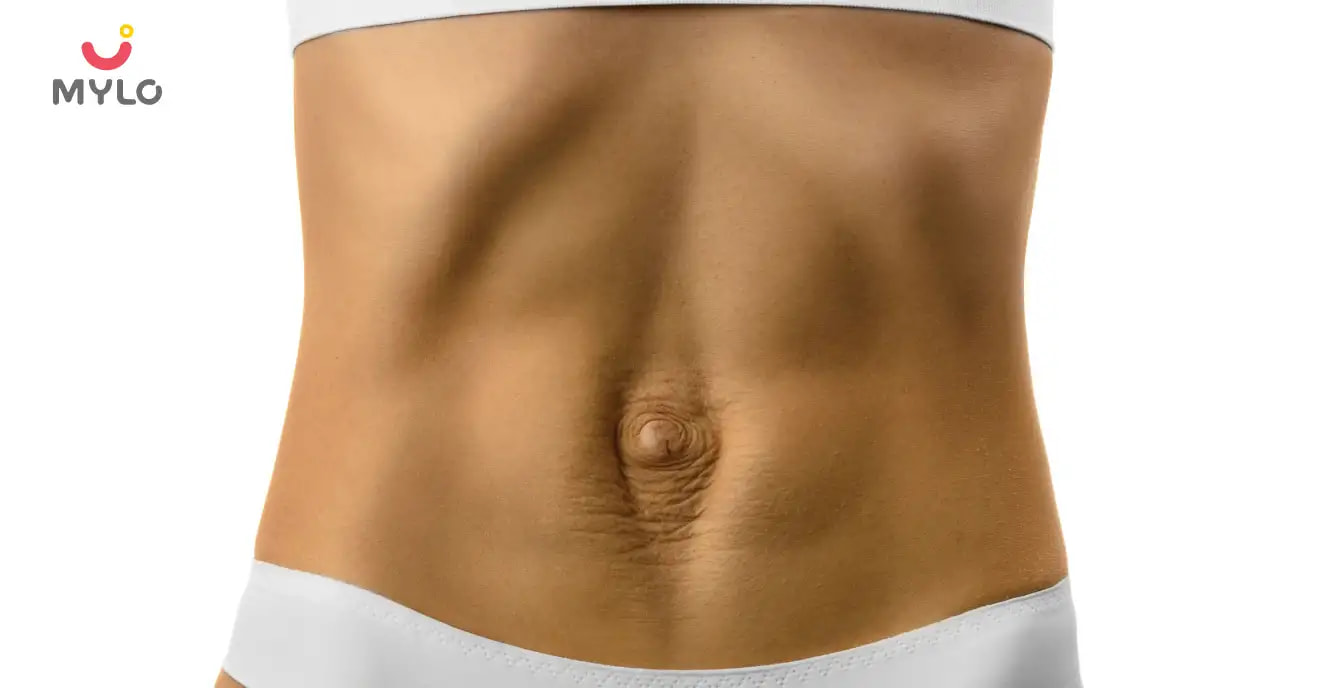Home

Women Specific Issues

Diastasis Recti: Causes, Symptoms, Risks & Preventions
In this Article

Women Specific Issues
Diastasis Recti: Causes, Symptoms, Risks & Preventions
Updated on 9 May 2023
Diastasis Recti is a common condition in pregnant and postpartum women. It happens when the rectus abdominal muscles separate during pregnancy due to being stretched. The separation can compel a woman's belly to stick out or bulge months or years postpartum. It can be repaired with specific exercises to help close the rift.
What Is Diastasis Recti?
Diastasis recti or diastasis rectus abdominis is the separation of the rectus abdominal muscles during pregnancy and postpartum. The rectus abdominis rides vertically along the front of your stomach. It's frequently referred to as someone's "six-pack abs." It's split into left and right sides by a band of tissue called the lines alba that rides down the middle. As your uterus enlarges during pregnancy, the linea alba thins and pulls apart, pushing this band of tissue wider outward.
Once you give birth to your baby, the linea alba can rebuild and come back together since it's highly elastic and retracts back. However, when the tissue loses its elasticity from being overstretched, the void in the abdominals does not close as much as it should, which is called diastasis recti. Your belly may seem to stick out just above or below the belly button if you have diastasis, making you appear pregnant months or years after giving birth.
Who Is Susceptible To Diastasis Recti?
Diastasis recti most commonly occur in pregnant and postpartum women. Diastasis recti usually develop during the third trimester. There is increased pressure on the abdominal wall during the third trimester since the baby is thriving. Most people overlook diastasis recti until the postpartum period.
How Common Is Diastasis Recti?
Diastasis recti are extremely common in women who are pregnant and in the postpartum period. It usually affects 60% of women. It generally resolves itself within eight weeks of childbirth. An estimate of about 40% of women with diastasis recti still have it by six months postpartum.
Symptoms Of Diastasis recti
Most women don't notice any diastasis recti symptoms until they are postpartum. You can develop diastasis recti during pregnancy because your abdomen is stretched and hard to distinguish. Some of the common diastasis recti symptoms during the postpartum period include:
-
A visible swelling that protrudes just above or below the belly button.
-
Softness or jelly-like sensing around the belly button.
-
Coning or doming when you contract your ab muscles.
-
Difficulty lifting weights, walking, or doing everyday tasks.
-
Pelvic pain.
-
Poor posture.
-
Urine leakage when you sneeze or cough.
-
Constipation.
-
Feeling weak in your abdominals.
Causes Of Diastasis Recti
Excessive inner abdominal pressure results in diastasis recti. During pregnancy, your uterus expands, stretching the abdominal muscles and connective tissues. They're supported along by pregnancy hormones relaxin and estrogen. Pushing during pregnancy can also cause diastasis recti. Experiencing some abdominal separation during and after pregnancy is normal. In the past, body mass index, weight gain during pregnancy, the baby's weight, and maternal age were considered risk aspects. However, a study found no connection between the factors and pregnant women being more or less likely to experience this condition.
Newborn babies, if premature, are sometimes born with diastasis recti because of the development of abdominal muscles.
Risk Factors For Developing Diastasis Recti
Numerous factors can increase your risk of developing severe diastasis recti:
-
Having multiple pregnancies.
-
Being over 35 years old.
-
Having a heavy or oversized foetus.
-
Being extremely thin.
-
Vaginal delivery since pushing can increase abdominal pressure.
Diastasis Recti: How Is It Diagnosed?
Your doctor will evaluate if diastasis is present, its location, and its severity. Diastasis recti can happen above the belly button, below the bell bottom, and on the belly button. Your doctor may use their hands and fingers to feel the abdominal area for gaps and muscle tone. Some doctors may also use ultrasound, measuring tape, or a caliper tool for more precise measurement. Examining this typically occurs at your postpartum appointment before being cleared for exercise.
An abdominal separation wider than two centimeters is considered diastasis recti. Diastasis recti are also calculated in finger widths, for instance, two or three fingers separation. Your doctor may recommend movements for diastasis recti, or they may advise you to a specialist for additional treatment.
How Can I Check Whether I Have Diastasis Recti?
You can check yourself for diastasis recti:
-
Lie on your rear, your knees bent, and your feet flat on the ground.
-
Lift your shoulders slightly above the ground, placing one hand behind your head for support. Just like you are doing a sit-up and looking down at your belly.
-
Place your other hand above your belly button, palms down, and fingers towards your toes.
-
Use your fingers to feel a gap between the abdominals. Check how many fingers can fit in the gap between your right and left abdominals.
How Can Diastasis Recti Be Repaired?
To repair diastasis recti, you'll require gentle movements that engage the abdominal muscles. Before beginning an exercise program, be sure it's safe for diastasis recti. Work with a health professional or physical therapist with prior diastasis recti experience. They can help to create a treatment plan to make sure you are performing the activities correctly and progressing to more challenging activities at the right time.
Specific movements can make abdominal separation worse. There are some changes that you should make during the postpartum period, which include:
-
Avoid lifting anything heavier than your infant.
-
Roll onto your side when leaning out of bed or sitting up, and use your arms to push yourself up.
-
Skip exercises and movements that push your abdominal muscles outwards.
What Exercises Are Most Effective For Diastasis Recti?
The practical exercises for diastasis recti are those that engage the deep abdominals. Most diastasis recti exercises include deep breathing and slow, controlled movements. However, many everyday activities, like crunches, can worsen your diastasis. Before beginning abdominal exercises, contact your healthcare provider to examine you for diastasis recti.
What Activities Worsen Diastasis Recti?
Any activities that bulge the abdominal wall forward can cause more damage to your diastasis recti. Everyday activities such as getting out of bed or up off a chair can worsen diastasis. Be mindful of how you use your abdominals as you go about your day. People with diastasis recti should avoid the following exercise movements:
-
Crunches or sit-ups of any type.
-
Planks or push-ups, unless using changes.
-
Downward dog, boat pose, and other yoga asanas.
-
Double leg lifts, scissors, and other pilates activities.
-
Any form of exercise causes your abdominal to bulge, cone or dome.
Preventing Diastasis Recti
Some abdominal separation is typical and expected with pregnancy. However, there are some things you can do to decrease your risk of developing diastasis recti:
-
Healthy weight gain during pregnancy: Exercising and consuming healthy foods to keep weight gain within a healthy range.
-
Proper posture and deep breathing: Always stand up straight with your shoulders back. Perform deep breaths that allow your ribs to expand and not just your belly.
-
Safe core exercises: Avoid sit-ups and crunches that exert pressure on your abdominals after 12 weeks of pregnancy and postpartum.
-
Don't strain while lifting: Specific day-to-day activities like carrying grocery bags or your children can strain your abdominals.
-
Log roll when getting out of bed: If pregnant or postpartum, roll onto one side and use your arms to get out of bed.
How Long Will My Diastasis Recti Take To Heal?
The time it takes to heal diastasis recti relies on the amount of abdominal separation and how consistent you are with strengthening exercises. The gap usually closes several weeks after postpartum as your muscles regain strength. If you change your lifestyle and perform activities with good form, you're more likely to notice progress.
Can I Redevelop Diastasis Recti?
Yes, you can help your diastasis recti and redevelop it again. Your chance of diastasis recti increases the more times you are pregnant. Linea alba is like a rubber band continuously stretched; over time, it loses its elasticity. The lines alba may not recover their original shape or form after being stretched through multiple pregnancies.
Are There Any Negative Effects From Diastasis Recti?
If left untreated or in severe diastasis recti cases, adverse effects can include:
-
Umbilical hernia, in extreme cases.
-
Increase in lower back pain.
-
Pain during sexual intercourse.
-
Urinary incontinence.
-
Pelvic and hip pain.
Summary
Diastasis recti can make you appear pregnant years after your baby is delivered. But rectus diastasis treatment can help you get back into shape. So, if you develop diastasis recti, speak to your doctor about your concerns to make a treatment plan, which likely includes a referral to a physical therapist who can help you to feel stronger and more confident about your postpartum body.



Written by
Khushboo Jain
Get baby's diet chart, and growth tips

Related Articles
Related Questions
Hello frnds..still no pain...doctor said head fix nhi hua hai..bt vagina me pain hai aur back pain bhi... anyone having same issues??

Kon kon c chije aisi hai jo pregnancy mei gas acidity jalan karti hain... Koi btayega plz bcz mujhe aksar khane ke baad hi samagh aata hai ki is chij se gas acidity jalan ho gyi hai. Please share your knowledge

I am 13 week pregnancy. Anyone having Storione-xt tablet. It better to have morning or night ???

Hlo to be moms....i hv a query...in my 9.5 wk i feel body joint pain like in ankle, knee, wrist, shoulder, toes....pain intensity is high...i cnt sleep....what should i do pls help....cn i cosult my doc.

Influenza and boostrix injection kisiko laga hai kya 8 month pregnancy me and q lagta hai ye plz reply me

Related Topics
RECENTLY PUBLISHED ARTICLES
our most recent articles

Medications
Opioid Overdose, Risk & Prevention

Pregnancy At 40
Is Pregnancy After 35 Right for You? A Comprehensive Guide

Symptoms & Illnesses
Clubfoot (Talipes Equinovarus): Meaning, Symptoms & More

Cold & Cough
RSV (Respiratory Syncytial Virus): Symptoms, Causes & Treatment

Love, Sex & Relationships
Loose Vagina: Learn How To Tighten Your Vagina Naturally

Umbilical Cord Complications
Umbilical Cord Prolapse Causes, Symptoms & Treatment
- Bipolar Disorder: Causes, Symptoms, Risks & Treatment
- Sinus Infection During Pregnancy Causes & Treatment
- Intrauterine Growth Restriction (IUGR) in Pregnancy
- APGAR Score: Meaning & How it is Performed
- Dyspareunia (Painful Intercourse): Causes & Treatment
- Short Bowel Syndrome: Causes, Symptoms, and Treatment
- Pelvic Inflammatory Disease (PID): Symptoms, Causes & Treatment
- Lightning Crotch in Pregnancy: All You Need to Know
- Vaginal Dilator: Learn its Types & How To Use It?
- Infected Umbilical Cord: Symptoms, Treatment And Prevention
- Is Hair Fall Normal in Pregnancy
- Syphilis: Symptoms, Causes, Risks & Treatment
- Congenital Heart Disease: Symptoms, Causes & Treatment
- Fetal Echo Test in Pregnancy: A Diagnostic Tool for Detecting Heart Defects in the Womb


AWARDS AND RECOGNITION

Mylo wins Forbes D2C Disruptor award

Mylo wins The Economic Times Promising Brands 2022
AS SEEN IN
















- Mylo Care: Effective and science-backed personal care and wellness solutions for a joyful you.
- Mylo Baby: Science-backed, gentle and effective personal care & hygiene range for your little one.
- Mylo Community: Trusted and empathetic community of 10mn+ parents and experts.
Product Categories
baby carrier | baby soap | baby wipes | stretch marks cream | baby cream | baby shampoo | baby massage oil | baby hair oil | stretch marks oil | baby body wash | baby powder | baby lotion | diaper rash cream | newborn diapers | teether | baby kajal | baby diapers | cloth diapers |








